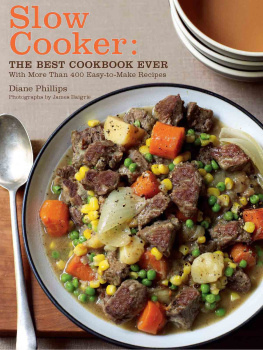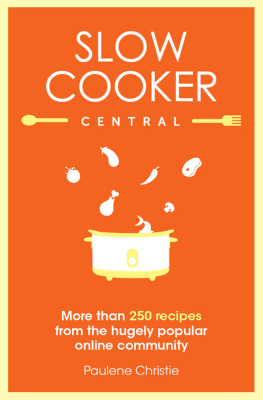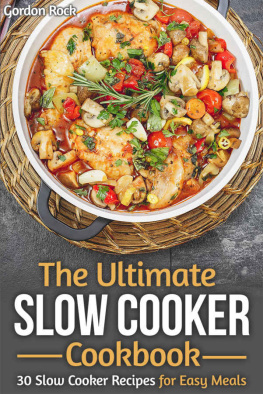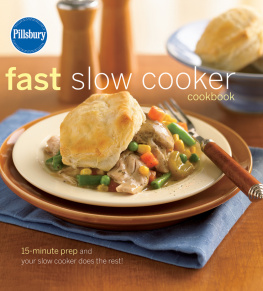
To Nancy Deason Boeninghausen; my profile in courage.
Whenever I look at my slow cooker, I think of the lyrics to that old Sinatra standard, Im not much to look at, nothing to see, but upon closer inspection the slow cooker is like the girl in high school who everyone said had a nice personality. This decidedly simple piece of equipment isnt the most attractive item ever to grace your kitchen counter but can it cook!
Slow cookers are the answer to that age-old question, Whats for dinner? You can smile and say, Its in the slow cooker. Slow cookers do all the work. You simply prep a few ingredients and let the cooker work its magic over the hours. Slow cookers are made for busy people who would love to have dinner made when they come home, but short of having a personal chef or eating take out, that doesnt happen. By prepping a few ingredients in the morning or the night before and then tossing them in the slow cooker when you leave for the day, you can return to a slow-cooked, deeply-flavored dinner ready to serve. The only job left is to prep a side dish or two and wait for the compliments.
Another advantage of the slow cooker is the aroma. This gives you an edge because when you open the door to your home, you are greeted with the aromas of slow-cooked goodness. Just smelling the food as you enter will make the work of the day a distant memory.
Many of my students have complained about the slow-cooker books on the market. There are either too many preparation steps, so that the dish is almost cooked before it goes into the cooker, or the flavors are washed out and bland and the dishes all taste the same. This book is dedicated to finding the balance between streamlined prep and full flavor, using fresh ingredients and a palate of flavors from around the world. So come along for the ride. Take the lid off that slow cooker, and lets find out what that appliance with the great personality really has to offer!
{Getting Started}
WHAT DOES IT DO?
Slow cookers operate on the principle of low and slow heat. The low setting on a slow cooker keeps food at 180F and the high setting at 300F. So think of high as a low and slow oven for braises, and low as a setting for longer and slower braises. Recipes for the low setting will cook at least 8 hours, about the time most of us would spend outside the home while at work or play. The beauty of the high setting is that a meal can be put into the machine and be ready in about 4 hours, about the time it takes to go to soccer, dance, and music lessons after school. Either way, youve got it madedelicious meal that cooks itself.
WHY DO I NEED ONE?
CONVENIENCE Slow cookers produce onepot meals with minimal prep and easy cleanup, and the slow cooker will keep an entree or side dish warm at the table. Instead of turning on the oven in the heat of summer, you can use the slow cooker as the oven and turn out great dishes.
SAVES TIME Slow cookers offer minimal preparation times and no fussing over the food once its in the cooker. You can literally set it and forget it.
SAVES MONEY Slow cookers use less electricity than a stovetop or oven, or about as much as a 75-watt lightbulb. Also, a slow cooker can produce delicious, meltinglytender meals out of less expensive cuts of meat.
NUTRITIONAL BENEFIT Because slow cookers should always remain covered, nutrients that might be lost in an oven or uncovered pot are retained.
WHAT SIZE SHOULD I GET?
If you bought this book, you either have a slow cooker that you arent using or are tempted to buy one. My advice is to buy what you will need, not what is on sale. There are lots of slow cookers to choose from, and they come in sizes from a 1-quart pot used to keep dips warm to a 7-quart cooker that will feed an army of hungry soldiers.
If yours is a two-person household but you love to cook and freeze your leftovers, then a 5- to 7-quart cooker would be my recommendation. If you are a two-person household but only want a meal and maybe a lunch leftover that week, then something in the 4- to 5-quart size is probably your best choice.
For families of four or more, Id recommend anything in the 5- to 7-quart range. Try a few of the recipes in the book, and you may decide you like this type of cooking so much you might get a an additional smaller or larger size. Remember that the slow cooker is a great tool when entertaining because it keeps dishes warm as well as cooks them.
CARE AND FEEDING OF THE SLOW COOKER
Food safety is always important, regardless of the equipment you are using. Make sure to wash your slow cooker insert thoroughly with hot soapy water, rinse it thoroughly, and dry it completely after washing. Keeping the outside clean is also important. The exterior of a slow cooker tends to get spotted with food stains, but cleaning those stains after cooling the slow cooker is a snap. Make sure to read the manufacturers directions on safe usage, cleaning, and storage of your slow cooker. Make sure to follow these simple rules for food safety:
Cool hot ingredients before adding them to cold ingredients.
Wash cutting boards thoroughly after each use and run them through the dishwasher if possible.
Use separate cutting boards for meats and vegetables.
Wash your hands thoroughly with soap and water before undertaking any type of prep work.
Recently slow-cooker liners have become available. Made of heatproof plastic, these liners are a lifesaver when you are making a dish that is guaranteed to stick to your pan. I also like to line the slow cooker when I am making a casserole. I will partially freeze the insert with the casserole until the casserole will hold its shape, then I remove the liner with the partially frozen casserole, wrap it in plastic wrap or in a zipper-top plastic bag, seal it airtight, and freeze it. When ready to cook, I then defrost the frozen casserole overnight in the refrigerator before putting it into the slow cooker the next morning. See individual recipes for instructions.
Some slow cookers come with a rack, which can be used to keep dishes like custard cups and ramekins from touching the bottom. Racks also help steam food at a constant temperature and are an added feature I find useful.
CONVERTING YOUR RECIPES TO THE SLOW COOKER:
If you have a dish that is braised on the stovetop or in the oven that you would like to convert to the slow cooker, follow these general guidelines.
| CONVENTIONAL OVEN OR STOVETOP | SLOW COOKER |
|---|
| hr | 1 hrs high/3 hrs low |
| 1 hr | 3 hrs high/6 to 7 hrs low |
| 2 hrs | 4 hrs high/9 to 10 hrs low |
| 3 hrs | 5 hrs high/10 to 11 hrs low |
Never fill your slow cooker more than two-thirds full. When foods give up their moisture over the long cooking process, you may find your cooker filled to the brim with liquid by the time you are ready to serve. Also make sure that the ingredients fill the slow cooker at least halfway, to ensure even cooking. If you dont have enough ingredients to fill the cooker halfway, your timing will be off.
TIPS AND TECHNIQUES FOR GETTING THE MOST FLAVOR
Chef Jose Andres, one of the worlds most renowned chefs, said that his father told him that every step in cooking is important. Andres expanded his fathers advice by saying every inglorious step helps you prepare dishes that are flavorful and memorable. So if you think that browning the meat before it goes into the cooker isnt important, remember that every step is important. I have tried where appropriate to streamline the prep so that it is minimal, but if I instruct you to brown, or stir, or lift the top off the cooker, its because the finished dish benefited from that step.
Next page








